
A heavy chorus of bolting and machinery filled the X-59 Quiet SuperSonic Technology, or QueSST, assembly building as engineers, system technicians, and aircraft fabricators worked to merge the major aircraft sections together, making it look like an actual aircraft for the first time since the initial cut of metal in 2018.
“We’ve now transitioned from being a bunch of separate parts sitting around on different parts of the production floor to an airplane,” said Jay Brandon, NASA chief engineer for the Low Boom Flight Demonstrator (LBFD) project.
NASA’s X-59 QueSST is under construction at Lockheed Martin Skunk Works in Palmdale, California, and is designed to fly at supersonic speeds – approximately 660 mph (1,060 kph) at sea level — without producing a startling sonic boom for people on the ground.
NASA will work with U.S. communities to understand their response to the aircraft’s sound and provide that data to regulators, which could change the rules that currently ban supersonic flight over land, cutting travel time in half for air travelers in the near future.
The Merger
With great precision and accuracy, the team used features on the structure to precisely self-locate the aircraft’s wing, tail assembly, and fuselage or forward section, then employed a series of laser projections to verify the precise fit.
“The extensive use of features and pre-drilled, full-size fastener holes has significantly reduced the time it takes to locate and fit parts, especially mating large assemblies like this,” said David Richardson, Lockheed Martin program director. “It is sort of like how Legos go together. We used the laser tracker to make sure it is all aligned per the engineering specs before we permanently bolted it all together.”
This time-lapse represents manufacturing of the X-59 Quiet SuperSonic Technology, or QueSST, aircraft from May 2019 to June 2021 and includes the merger of its main sections — the wing, tail assembly, and fuselage or forward section. The first flight of the X-59 QueSST is planned for 2022. Credit: Lockheed Martin
The mating of these major hardware components was a breath of fresh air for the team.
“A milestone like this — seeing the airplane coming together as a single unit — really reinvigorates and motivates the team,” said Dave Richwine, NASA’s LBFD deputy project manager for technology.
Fuselage
The aircraft’s fuselage contains the cockpit and helps define the shape of the X-59. Eventually the 30-foot-long (9-meter-long) nose of the aircraft will be mounted to the fuselage.
Part of the cockpit is something you might see in an office. The pilot will see the sky ahead through a 4K computer monitor, which will display complex computer-processed imagery from two cameras mounted above and below the X-59’s nose. NASA calls this forward-facing “window” the eXternal Vision System or XVS.
The XVS serves as an additional safety aid to help the pilot maneuver safely through the skies. This cutting-edge vision system is necessary because the desired shape and long nose of the X-59 won’t allow for a protruding cockpit canopy.
The X-59’s unique shape controls the way the air moves away from the plane, ultimately preventing a sonic boom from disturbing communities on the ground.
Wing
The most recognizable part of the airplane – the wing – was “the most complicated section and first section of the X-59 that was fabricated by Lockheed Martin,” explained Richwine. Housed within the 29.5-foot-wide (9-meter-wide) wing are the aircraft’s fuel systems and a large portion of its control systems.
The Lockheed Martin team used robotic machines with names that sound like pilot call signs – Mongoose and COBRA – to manufacture the wing before it mate to the tail assembly and fuselage.
Mongoose is a tool with the ability to weave together composite wing skins using ultraviolet light to bind the composite material. COBRA — Combined Operation: Bolting and Robotic AutoDrill – efficiently created holes that allowed the team to attach the wing skins to the wing frame.
Tail Assembly
The tail assembly contains the engine compartment. This section is built with heat-resistant materials that protect the aircraft from the heat given off by the X-59’s GE F414 engine.

The engine is in the upper section of the X-59. Similar to the XVS, it is one of many purposeful design elements that ensure the aircraft is shaped as desired to produce a quieter noise to the people below.
What’s the point of the X-59 – apart from it just being ‘plane’ cool?
The X-59 – the visual centerpiece of the mission — definitely brings in the cool factor, but the data part of NASA’s mission — the nerdy part – is what will revolutionize speedy commercial air travel over land.
NASA’s quiet supersonic mission involves building the X-59 (happening now) and conducting initial flight tests starting in 2022.
In 2023, NASA will fly the X-59 over the test range at the agency’s Armstrong Flight Research Center in California to prove it can produce a quieter sonic thump and is safe to operate in the National Airspace System. More than 175 ground recording systems will measure the sound coming from the X-59.
In 2024, NASA will fly the X-59 over several communities around the nation to gauge people’s response to the sonic thump sound produced by the aircraft – if they hear anything at all. The data collected will be given to the Federal Aviation Administration and the International Civil Aviation Organization for their consideration in changing the existing bans on supersonic flight over land.
That ban went into effect in 1973 and has plagued commercial supersonic ventures ever since, restricting faster-than-sound travel only to flights over the ocean. British Airways and Air France flying the Concorde were two airlines that offered such service between 1976 and 2003.
If rules change because of NASA’s data, a new fleet of commercial supersonic aircraft become viable, allowing passengers to hop on a plane and arrive from distant destinations in half the time. Though the single-piloted X-59 will never carry passengers, aircraft manufacturers may choose to incorporate its technology into their own designs.
The Future Awaits
With an eye to the future, the team is rigorously working on the final assembly of the X-59, which will mark the end of manufacturing.
In late 2021, Lockheed Martin will ship the X-59 to a sister facility in Ft. Worth, Texas, where ground testing will be done to ensure the aircraft can withstand the loads and stresses that typically occur during flight. There, the team also will calibrate and test the fuel systems before the X-59 makes the journey back to California for more tests.
Though seemingly a long way away, community overflights, data collection, and a possible new commercial market for supersonic flight over land is just around the corner.
1 Comment
These fantastic multi mach planes are a testiment to engineers prowess in overcoming major engineering challenges, they give me goosebumps. I grew up on Thunderbirds International Rescue plus Concorde where science & engineering seemed so easy and consequences be damned.
Its a pity then that they will inevitably use an order of magnitude more fuel and emit an order more CO2 per passenger so the elites can get to the restaurant in Paris before they left and come home in time for deserts. Extreme jet plane users are likely using several times as much energy per capita as regular people in the US. So 300GJ/yr turns into 1000GJ/yr, but thats probably about the max limit of energy use. A KWh is 3.6MJ so 300GJ/yr is about 82,000 KWh/yr about 1000 Tesla cars worth of battery charge or 8gals of fuel every day.
The book “Without the hot air” is a good book on energy use by physicist David MacKay. It even covers how planes and all transport use energy.
Also Wikipedia, per capita energy use.